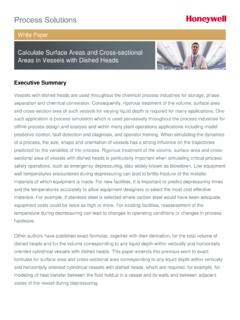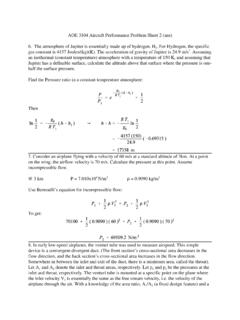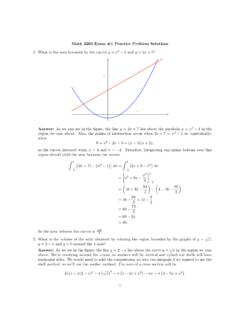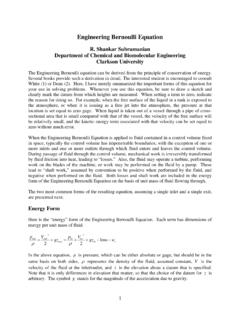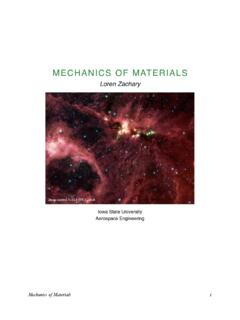Transcription of Stream Classification using the Rosgen System
1 COMPANION DOCUMENT 580-5. Stream Classification using THE Rosgen System . 1. Identify bankfull elevations and mark cross -sections. Identify the bankfull elevation by walking along a reach that is 20-30 times the bankfull width long, marking bankfull indicators with flags. This usually includes at least three meander bends. Choose three locations to measure cross -sections, placing them at crossovers, where the thalweg switches from one bank to the other. The flags help identify bankfull elevation even when indicators are not present at selected cross -sections.
2 Figure 1: Recommended cross -section locations for bankfull stage measurements in "riffle/pool" System Figure 2: Recommended location for measurement of bankfull stage in "step/pool". System EFH Notice 210-WI-119. February 2009. COMPANION DOCUMENT 580-5. 2. Survey cross -sections. Measure a Stream channel cross section. This means surveying the cross section from bankfull elevation on one bank to the other bank. You will need to survey up into the flooplain as well (see step 3). Wisconsin Job Sheet 811, Stream Channel Classification , may be used to aid in Classification .
3 Figure 3: Measuring a Stream channel cross -section In the above diagram: bankfull width is the distance between the banks at bankfull stage (dashed arrow). maximum bankfull depth is the difference in elevation between the bankfull stage and the deepest part of the cross section (red arrow). bankfull depth or mean depth is the cross sectional area at bankfull divided by the bankfull width. See step 7 for detailed instructions on calculating mean depth. In Wisconsin, the bankfull elevation is roughly the water elevation during the year discharge.
4 The bankfull elevation is the same as the ordinary high water mark (OHWM). In many channels this is the point where water begins to flow out onto its floodplain. Since floodplains may be small or inconspicuous in some Stream types where the floodplains are naturally indistinct, it is important to verify correct identification of the bankfull surface by checking it against the year discharge. Your geologist or engineer can provide assistance in determining the bankfull elevation and bankfull discharge and return interval.
5 Several methods of determining bankfull discharge are provided in NEH 654, Stream Restoration Design, Chapter 6, Stream Hydraulics, Wisconsin Supplement, Hydraulics for Design. Discharge can also be found indirectly by using Manning's equation to find the velocity and then multiplying that by the cross sectional area . Several methods of determining Manning's n are provided in NEH 654, Stream Restoration Design, Chapter 6, Stream Hydraulics, Wisconsin Supplement, Hydraulics for Design. EFH Notice 210-WI-119.
6 February 2009. COMPANION DOCUMENT 580-5. 3. Determine the entrenchment ratio. Determine the floodprone elevation and measure the width. To find the floodprone elevation, take the maximum depth from the bankfull elevation to the Stream bed and multiply by 2. Measure the width at the floodprone elevation. Divide the width at the floodprone elevation by the width at bankfull elevation to determine the Entrenchment Ratio. The floodprone elevation roughly represents the water elevation during the 50 year discharge.
7 Figure 4: Floodprone width and Entrenchment Ratio EFH Notice 210-WI-119. February 2009. COMPANION DOCUMENT 580-5. 4. Measure the water surface slope (gradient). Slope is measured between two bed features of the same type (top of riffle to top of riffle or center of pool to center of pool). Measurements should be accurate to the hundredths level because Stream gradients are often low. Wisconsin has many C and E Stream types which tend to have flat gradients in the range of to feet/feet. Be sure to measure a reach that is long enough - at least 20 times the width at bankfull.
8 Figure 5: Measuring Stream gradient through a typical riffle/pool sequence EFH Notice 210-WI-119. February 2009. COMPANION DOCUMENT 580-5. 5. Measure the sinuosity of the Stream . For small streams, this can be done with a tape measure. Measure the length along the Stream and measure the length of the valley for the same reach of Stream . In other cases, these measurements can be made using an aerial photo. Figure 6: Channel Sinuosity Calculations EFH Notice 210-WI-119. February 2009. COMPANION DOCUMENT 580-5.
9 6. Pebble Count. Take a pebble count of the material in the active channel. First, determine the percentage of the reach in pools and the percentage that is riffles. Take ten measurements at ten different locations as shown below. Calculate the D50 particle size. Pebble count data can be taken on Wisconsin Job Sheet 810, Pebble Count ftp://ftp- If desired, pebble count data can be entered into the free Ohio DNR Stream Modules developed by Mecklenburg and others Stream Morphology - Modules. The spreadsheet will plot the pebble count and determine D50 for you.
10 Figure 7: Pebble count procedure Figure 8: sand gage EFH Notice 210-WI-119. February 2009. COMPANION DOCUMENT 580-5. 7. Mean Depth (Bankfull Depth). Find the mean depth at bankfull. Determine the area of the cross section. It may be easiest to divide the cross section into cells and compute the area of the cells and then add the areas of the cells together. area can also be found by plotting on grid paper and counting squares or calculating on a CAD System or using the Wisconsin spreadsheet area By Coordinate Method.










